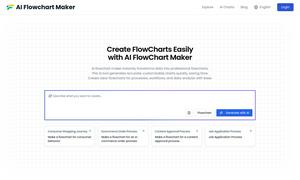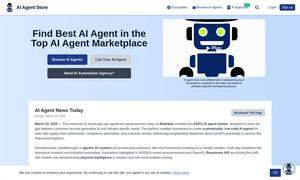
Discover the Best AI Tools to Boost Your Productivity
Find the Best AI Tools to Optimize Your Work and Personal Tasks
Best Data Analysis AI Tools in 2024


What is Data Analysis
The Data Analysis Category encompasses advanced methods for interpreting complex data sets, enabling businesses to make informed decisions. By leveraging powerful tools, users can uncover trends, patterns, and insights, driving efficiency and innovation. This category emphasizes accuracy and actionable intelligence, empowering organizations to optimize operations.
How Data Analysis works
To effectively use the Data Analysis Category, users typically follow a structured process that starts with data collection, followed by cleaning and organizing data sets to ensure accuracy. Next, various analytical tools and techniques are applied, such as statistical analysis and data visualization. Users interpret the results, drawing conclusions that inform decisions. This systematic approach, employing unique methodologies like predictive analytics and machine learning, helps users transform raw data into actionable insights, ultimately driving business success.
What are the advantages of Data Analysis?
The Data Analysis Category offers numerous advantages, including enhanced efficiency and improved decision-making accuracy. By providing access to sophisticated analytical tools, it enables organizations to derive valuable insights from their data, leading to innovative strategies and optimized operations. Its practical applications across industries further underscore its importance, making it a vital resource for professionals aiming to meet evolving market demands.
Key Features for Data Analysis
Predictive Analytics
Predictive analytics is a standout feature of the Data Analysis Category, enabling users to forecast future trends based on historical data. This unique functionality provides businesses with the foresight needed to make proactive decisions, enhancing strategic planning and resource allocation for better outcomes and increased competitiveness.
Data Visualization
Data visualization is an essential feature within the Data Analysis Category, transforming complex data sets into intuitive graphical representations. This enhances user comprehension, allowing stakeholders to interpret insights at a glance, thus fostering collaborative decision-making while driving efficiency and clarity in data-driven discussions.
Statistical Analysis Tools
Statistical analysis tools are a key feature of the Data Analysis Category, providing users with advanced techniques for applying statistical methods to their data. These tools enable in-depth exploration of data patterns, ensuring that businesses can base their decisions on robust insights derived from accurate statistical computations.
Use Cases for Data Analysis?
The Data Analysis Category is beneficial in various scenarios, such as market research, financial forecasting, and performance optimization. Businesses may utilize it to analyze customer behavior, assess the effectiveness of marketing campaigns, or streamline supply chain operations. By addressing specific challenges, such as understanding consumer trends or validating strategic initiatives, it ensures that organizations can make data-driven decisions that foster growth and competitiveness.
FAQs for Data Analysis
How does predictive analytics enhance decision-making in the Data Analysis Category?
Predictive analytics enhances decision-making in the Data Analysis Category by using historical data to identify trends and forecast future outcomes. This enables businesses to anticipate market changes and customer behaviors, leading to proactive strategy formulation. With actionable insights derived from predictive models, organizations can optimize operations and reduce risks, ultimately driving growth and success.
What role does data visualization play in data analysis?
Data visualization plays a crucial role in data analysis by simplifying the interpretation of complex data sets. It transforms numerical data into visual formats like graphs and charts, making it easier for users to identify trends, patterns, and insights. This feature enhances communication among stakeholders, facilitating effective collaboration and informed decision-making across teams.
How do statistical analysis tools support businesses in data analysis?
Statistical analysis tools support businesses in data analysis by providing methods for examining data variability and relationships. These tools enable users to apply statistical tests, quantify uncertainty, and validate hypotheses, leading to more reliable insights. By leveraging these capabilities, organizations can make informed decisions backed by rigorous data analysis, driving operational efficiency and strategic growth.
What makes predictive analytics a competitive advantage in the Data Analysis Category?
Predictive analytics provides a competitive advantage in the Data Analysis Category by enabling organizations to anticipate trends and customer needs before they emerge. This foresight allows businesses to tailor their strategies and offerings, leading to enhanced customer satisfaction and loyalty. By staying ahead of market shifts, companies can secure their position and outperform competitors through informed, proactive decision-making.
What specific benefits do organizations gain from using data visualization?
Organizations gain significant benefits from using data visualization, including improved clarity and understanding of data insights. By presenting data visually, stakeholders can quickly identify trends and correlations that may be overlooked in traditional reports. This enhanced visibility leads to better collaboration among teams, more informed decisions, and ultimately, greater operational efficiency and alignment with business goals.
How can users maximize the benefits from the features in the Data Analysis Category?
Users can maximize the benefits from features in the Data Analysis Category by integrating them into their decision-making processes. By employing predictive analytics to forecast trends, utilizing data visualization for clarity, and applying statistical analysis to validate findings, organizations can create a robust framework for data-driven insights. Consistent use of these tools enhances strategic planning and operational effectiveness, driving overall success.





